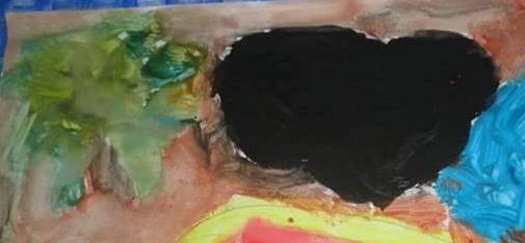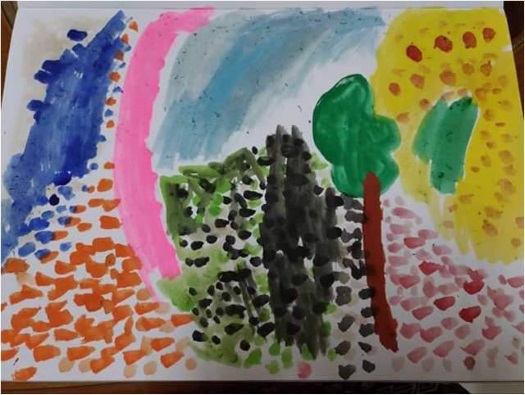Poetry in Motion as a Key to Learning Success
Vasiliki Mandalou, Greece
Vasiliki Mandalou is a Philology and Linguistics freelance teacher. Her BA is on Classic and Modern Greek and she holds a MSc on Special Needs Education & Mental Health. She teaches Literature and Philosophy to all levels of learners and Autistic pupils and runs her two projects entitled: “Poetry in Motion” and “Philosophy for children, Philosophy for wellbeing”. She holds a Cambridge CELTA degree and has been a practicing teacher of Modern Greek and English for the past 18 years. Vassiliki has been serving on the board of TESOL Macedonia-Thrace, Northern Greece since 2015 and in her free time she enjoys writing poetry in both languages. E-mail: vassilikimandalou@gmail.com

Hope haiku (5-7-5)
by Vasiliki Mandalou
‘What is hope?’ I asked.
And the wild poppy stood up
Even more scarlet.
Menu
Introduction
Some ideas on how poetry can be used in practice
Adult learners
Lesson plan
Aims and results
Autistic children
Closing remarks
References
Poetry means creation and we as teachers are called to be creative in order to invent various ways so as to approach, and teach our pupils.
The Poetry in Motion project has been based on the notions of creative self space as well as on the kinesthetic approach of language learning. Creative self space is the personal space (the elbow room as it’s often called) where the learner feels safe, free and able to collaborate and communicate. Language, on the other hand, is itself a movement, a “kinesis” and thus its teaching and comprehension are- or at least should be- based on the contribution not only of the mind, but also of the soul (aka emotions and how to identify them) and body ( movements, body language, colour of voice). We can see that those two notions are well bonded by their nature. Let alone when creativity (ora Poetry = ‘poiesis’) becomes their graceful glue.
I would like to present how I have used this ‘tool’ in two groups of learners: Adult learners beginners in English language and Autistic children.
These learners face specific difficulties when it comes to learning something new because they already have knowledge and experience on things around them, they already carry their own ‘mental luggage’ and thus it’s rather difficult to ask them to ‘unlearn’ and learn anew. Most of my adult learners were teachers themselves, many of them for very long time or pensioners, which means that the stereotypes on how the learning process should take place are fixed. Moreover, adults find it harder to express their emotions, hopes or aspirations. So we first need to unlock this area. In psychology this is known as ‘Emotional Intelligence” and in order to manage it, one must first learn to identify and then find poetic ways to express it. Please bear in mind that that the terms ‘poetry’ and ‘poetic’ do not refer only to the literature genre but rather they characterize the creativity in combination with the motion. As you may have noticed this emotional identification, awareness and expression is a movement, a motion. Because motion is not only something related to physical movement but first and foremost to the movement that derives from our inner cosmos.
- I have taught vocabulary based on emotions (adjectives & verbs) We already know the colours and we already know adjectives that characterize matter and people (smooth, hard, rough, soft, etc.).I ask students to take a big breath and write down on a piece of paper what their current emotional status is. This exercise is done anonymously.
- Our next step is to visualize what colour this emotion could be by asking them: “if this emotion was a colour, what would it be?” Noting it down again right under.
- Students then proceed to justify why they chose that colour. For example: ‘’My feeling right now is blue, because it feels like the sea and the sky.’’ Students note this down again.
- “If this emotion was an object, what would it be and why?” Students note this information below what they have previously written.
- “If this emotion was a sound/ music/melody, what would it be and why?” Again students note everything down.
- I collect those papers and re-share them making sure that each person has been given someone else’s writing.
- I give them time to read them and then I ask them the final question:”If what you read was a movement or a pose, what would it be?”M
As already mentioned, the aims are to make adults not only think, but rather dare to feel and find the words that best describe their emotions. That is, to motivate them to see what they are feeling and why they feel this emotion, how they can describe it by justifying their choices and of course how to present it by using movement too. The challenge for the teacher is what to do so that our adult learners will not feel shy or awkward, as they do not have to read aloud their own writing. It should be noted here that most people feel better when someone else is reading or narrating their writing instead of themselves. In other words their personal self space is secure but they do have the freedom of presenting aloud someone else’s work. Also, the person who listens and sees the representation of their writing by another person (do not forget we talk about poetic= creative emotional awareness here, i.e. ‘Intelligence’…) has the chance to do an inside job, which is either self correction or- mainly- self awareness of how their emotions are received by the others. After all that’s what we, language teachers, are called to offer and what language is all about: a communicative approach of our own self, communication and sharing our emotions through the right use of language. Vocabulary is used, also grammar tenses can be used, if we for example ask our learners to put everything in the past or future tenses, etc. Speaking is also practiced and the bonus is that we get rid of any kind of shyness while speaking to an audience. What students produce in the end closely resembles a poem, such as the one below.
“Loneliness”
Grey.
Grey like the sky.
The heavy sky.
Heavy and full of tears.
Silent rain in my soul.
(by Mr. George P. 57 years old, math teacher, third year of English lessons)
The truth is that each learner is an individual and I have always believed that we are all learners, with our own special needs and our own special difficulties, throughout our lifetime since learning lasts as long as our lives. Autistic learners, in particular, have to deal with some additional complications, for examples some find it hard to speak. Non-verbal autistic children cannot talk and most of the time the autism spectrum is escorted by the ‘unknown mental syndrome’, which makes things even more difficult. At this point, I would like to post only in pictures the before and after stages of my Poetry in Motion sessions with one of my non-verbal autistic learner.. Despite the student’s condition, we managed to overcome the child’s initial fear of colours and sounds after 10 years of work. Therefore, the student can now ‘speak’ via shapes and movements and thus express himself. This has helped him to stop feeling alone and lonely. Language, even if non-verbal can ‘’speak’’ and language learners can definitely communicate. Presenting a how-to lesson plan targeted on autistic learners would be a utopia, as each time we have to adapt and modify the plan and the material several times during the session itself. Moreover, it would be more helpful if it’s given as a workshop rather than a lesson plan this exact theme.
If you notice the Before image, you will see blurred shapes, angry patterns, a few mixed colours and a black heart.

If you now look at the after picture the theme of the painting, the colours, the shapes are a justification of the students’ current emotional state. We can see hope, movement from inside-out, and movement from sadness to understanding and knowing.

Closing this article here, I would like to say that if teachers realize and move from the unit to the team, if we first set the example of creative expression and Emotional Awareness in our personal lives and as a result in our classrooms, then miracles of verbal and non-verbal speech will occur!
Dr Attwood, T. «Asperger's Syndrome: A Guide for Parents and Professionals» article on: http://aspergerhellas.org/Edu-Asperger.html
Glavas, Is., Lesson plan, research-Γλαβάς Ισίδ., Σχέδιο μαθήματος, μελέτη: http://blogs.sch.gr/isiglavas/archives/719
Kennedy D. and all, (2002), The ADHD-Autism Connection: A Step Toward More Accurate Diagnoses and Effective Treatment. (2002) , Waterbrook Press, Colorado. USA.
Kritseli, G. ‘’Autistic children or charismatic children?” article published in Eleftherotypia newspaper on 16/09/2008 http://aspergerhellas.org/Edu-GiftedChild.html
(the text can also be retrieved from www.disabled.gr)
Mandalou, V. Poetry in Motion: a Kinesthetic approach to teaching. presentation at 23rd Tesol Macedonia-Thrace, Northern Greece Annual International Converence, Thessaloniki, March 2014 & ELTA Serbia International Convention, Belgrade, May 2016, 3rd EEPEK International Educational Conference on Creativity and Motivation, Larissa, Greece, October 2017.
McAfee, J. (2001), Navigating the Social World: A Curriculum for Individuals with Asperger's Syndrome, High Functioning Autism and Related Disorders. Future Horizons, USA,
What kind of help would an autistic pupil to have from his teachers in school, Research article published in : http://aspergerhellas.org/Edu-Letter.html

Please check the Creative Methodology for the Classroom course at Pilgrims website.
Please check the Methodology and Language for Secondary course at Pilgrims website.
Please check the Special Needs and Inclusive Learning course at Pilgrims website.


|